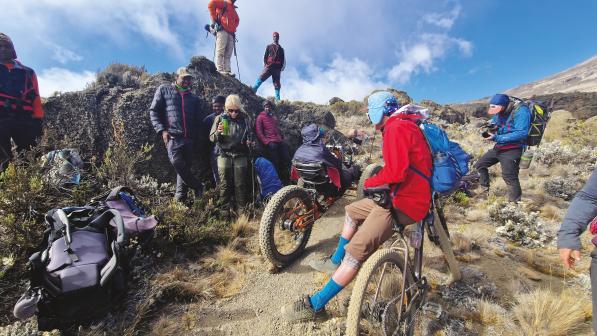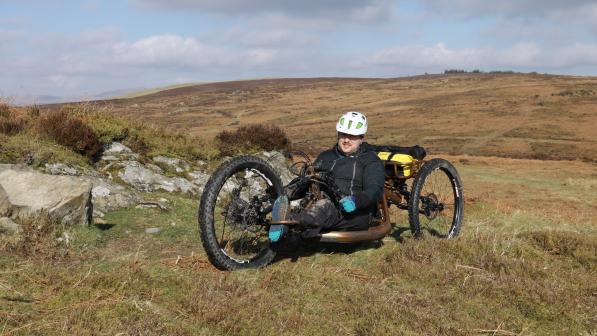Back in the saddle – returning to cycling after injury

We’ve all seen stories of professional athletes returning to their chosen sport after a serious injury. As inspiring as they are, it can be hard for us ‘mere mortals’ to relate. Athletes are at the peak of their fitness, surrounded by the best medical, training and healthcare teams in the world.
For those of us without these resources, the idea of getting back to cycling after a life-changing incident like a stroke or loss of a limb might feel unachievable. But, as the saying goes, nothing’s impossible. I talked to two people who have experienced such an incident about how they got back in the saddle.
Janet Atherton has been chair of Cycling UK’s Board of Trustees since January 2021. In May 2023 she suffered a mild stroke. After experiencing stroke, you can’t drive for a minimum of one month. Naturally, she wanted to know if she could cycle – at this point she was lying in a hospital bed and had no use of her left hand.
Andrew Moult is a former Royal Engineer who had cycled since he was a boy. He retired from the army in 1984 after badly injuring his leg. At that point he could still run, but from 1989 his leg deteriorated. He had a stroke, and then a heart attack and pulmonary embolism.
He was lucky to be alive but became a full-time wheelchair user and started putting on weight. “I was sitting there one day thinking ‘I wish I could cycle. I really do wish I could do some cycling’,” he said to me.
The right bike – or trike
I’ve previously written about returning to cycling after an injury, and much of the same advice applies to these much more serious, life-changing injuries. However, cycling can be especially beneficial for anyone who has experienced this.
You can start off indoors with a stationary bike if balance or fitness are issues. It’s also easy to gradually build up stamina and distance. Group cycling provides support and accountability.

You can also adapt your own riding style to your new reality, while standard bikes are themselves eminently adaptable. On top that, there’s a plethora of different cycles for all kinds of injuries, from e-bikes for a bit of extra oomph to handcycles for those with limited use of their legs.
I cycled to Paris with a woman who had suffered a serious brain injury. She could no longer use a standard cycle but was determined that her injury wouldn’t stop her cycling, so she invested in a trike. The whole group cheered when three of the mechanics managed to lift her and her tricycle up for that famous photo in front of the Eiffel Tower.
Dr Kay Inckle of inclusive cycling charity Wheels for Wellbeing says: “Cycling can be a fantastic way to exercise and to keep mobile, independent and feel good after a life-changing injury or health experience.
“However, it’s not always obvious what cycle is going to work for each individual and it’s really important that people feel safe, comfortable and have just the right level of physical challenge/input while cycling.
“We recommend that someone goes along to an inclusive cycling centre (they are all over the country) where they can try out a whole range of different cycles in a safe, off-road environment with specially trained instructors. Electric assistance is important for many disabled cyclists, and it’s worth trying different types of e-cycles.”
Electric avenues
Janet describes her e-bike as a “godsend”. She had only bought it the previous Christmas. Her other bike is a tourer, which she wasn’t sure she would have been able to ride after the stroke.
The e-bike, however, with its smaller wheels, lower standover, more upright position and flat handlebar, meant the only adaptation she had to make was to drop the saddle slightly: “I dropped the saddle a tiny bit, just about half a centimetre, so I was able to push off, put the battery on high, and get going without wobbling so much.”

These days Andrew rides a Freedom Ryder electric handcycle but he started out rather differently. After doing some research he found it was possible to get a clip-on handcycle for wheelchairs. However, these only work on rigid-framed wheelchairs, which aren’t available on the NHS. Buying one would cost about £4,000.
As an engineer, he knew there must be a solution, so he got some gas pipes and built a frame for his wheelchair that the handcycle could clip into. He was, he says, “elated” because he could cycle again. “It was hard because it uses a different technique and different muscles, but I could do it.”
But disaster struck: when Andrew took the wheelchair in for a service a crack was found. “This never happens,” he was told. He had to explain about the frame and clip-on and was told he had to remove it as he was damaging NHS property. This “brought me down again, so I did some more research”.
Andrew’s first complete handcycle was from Mission Cycles, which specialises in trikes for disabled cyclists. He fitted an electric motor and later a 7-speed Sturmey Archer hub. “I was absolutely over the moon,” he says. “What things could I do now? I went from strength to strength.”
A phased return
The main advice for anyone returning to cycling after a life-changing injury is to take things very slowly and build up time spent on the bike gradually. Scott Weddell works for the Stroke Association, and is also a Bikeability instructor and Cycling UK member. He advises getting professional assistance.
“Lots of people come to me because they’re struggling with physical effects, such as their balance,” he says. “We start off by going right back to the basics and building up from there, practising techniques and finding adaptations to help them progress.”

Janet started off doing just seven minutes on an exercise bike, and was “knackered, whereas previously I would have been doing it for an hour and would have been fine”. At this point she couldn’t cope with riding outside but was determined to do so before her next consultant review.
She took her bike to a cemetery across the road and managed a two-mile ride. She slowly built up distance. “I was going over a couple of times a week and gradually building up the mileage. I got to know the gardeners very well!” She eventually built up to 10 miles, which she admits “took some doing”.
Similarly, Andrew started with a five-mile ride on his first handcycle, building up to 30 miles and losing seven stone in the process. Since then he has become the first person to complete the Trans Pennine Trail on a handcycle. He has cycled the 60-mile version of Ride London and is now in training for the 100-mile route.
This slow-but-steady approach is vital to building confidence too. Both Janet and Andrew say that their own lack of self-belief was a major barrier to overcome. Andrew comments: “The hardest thing was to convince myself to do it. I’d lost a lot of confidence in myself. I’d lost a lot of get up and go.”
Andrew thanks wife Chris for giving him the push to get out there, while Janet is grateful for the support of friends. She rode with a friend on an old railway line that’s now a shared-use path. Riding 12 miles, they also stopped at a café.
“It was proper back-to-normal time,” she says. “I did a teeny bit on the road right at the end, which really helped build up some of that confidence to be on the road.”
Ultimately, both have the same advice: “Just go for it!”
Cycle magazine
Every two months Cycling UK members receive Cycle magazine, filled with interesting and informative articles, news and reviews for all cyclists.
Members can read the magazine in full online; non-members can read selected highlights.



